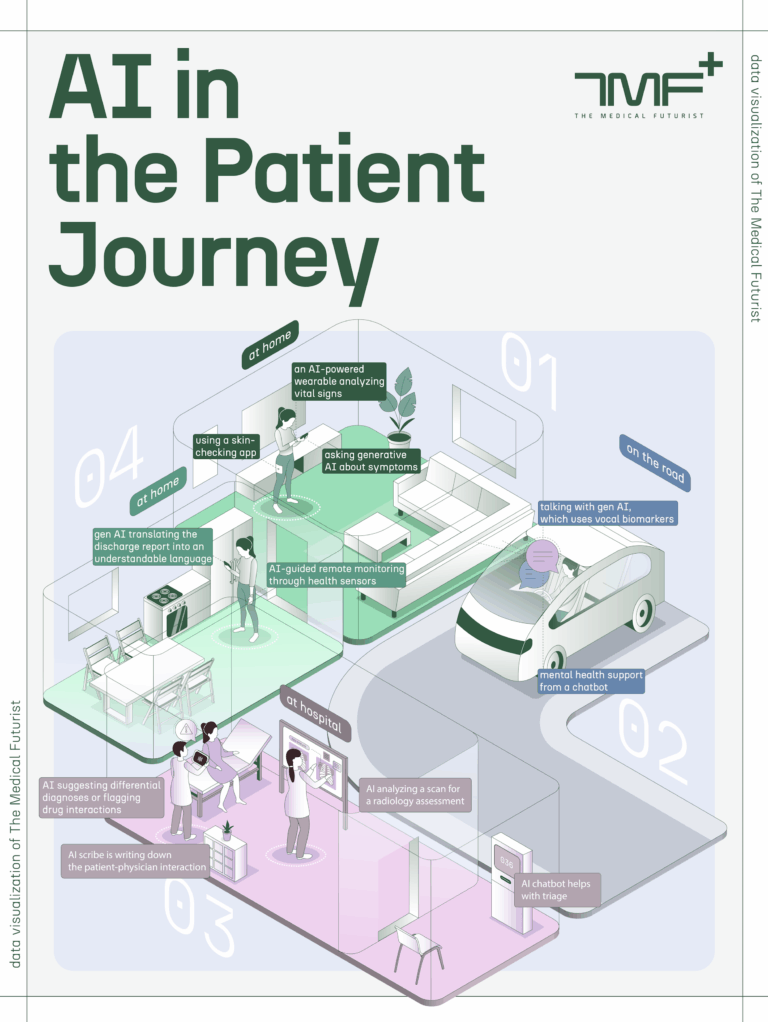The Medical Futurist – Read More
Artificial intelligence (AI) is no longer a distant promise in healthcare, but it has quietly become a companion at every step of the patient journey. From the moment someone checks a symptom at home to the way they’re triaged in an emergency department or guided through recovery after discharge, AI tools are weaving themselves into everyday care. This transformation is less about robots replacing doctors and more about invisible digital helpers that translate reports, flag drug interactions, analyze scans, and even pick up subtle changes in a patient’s voice or vital signs. In this article, we explore how these technologies shape each stage of the patient experience — at home, on the road, in the hospital, and back home again.
All these have been summarized in the infographic below.

To describe use cases, we follow a fictional patient named Anna through her journey: waking up with her wearable, asking a generative AI about symptoms, getting mental-health support in the car, interacting with an AI scribe at the hospital, then going home with an AI-translated discharge note.
 At Home – Morning
At Home – Morning
Anna wakes up feeling a strange chest discomfort. She grabs her phone and asks a generative-AI assistant about her symptoms.
She notices a mole on her arm and opens a skin-checking app, pointing her phone’s camera at the spot.
Meanwhile, her AI-powered smartwatch quietly tracks her heart rate, blood oxygen and sleep quality — and even talks to her when it spots an irregular pattern.
 On the Road
On the Road
While driving to the clinic, Anna speaks to her in-car voice assistant, which analyzes her speech for vocal biomarkers that could reveal early health issues.
She also activates a mental-health chatbot to help calm her anxiety during the ride.
 At the Hospital
At the Hospital
When Anna arrives, an AI-driven triage chatbot quickly sorts patients by urgency so she doesn’t wait longer than needed.
During the consultation, the doctor focuses fully on her — an AI scribe on the phone automatically writes the medical notes in the background.
Her chest X-ray is uploaded, and an AI radiology tool flags subtle signs that deserve the doctor’s closer look.
Another AI clinical-decision app pops up an alert on the doctor’s phone, warning of a possible drug interaction.
 Back Home – Evening
Back Home – Evening
Later that day, Anna receives her discharge papers; a generative-AI translator rewrites the report into plain language so she understands every term.
At night, her remote-monitoring sensors keep watch on her vital signs and send updates to the clinic — without her lifting a finger.
Imagine waking up with a smartwatch that quietly tracks your vital signs, pointing your phone at a mole for an instant skin check, or asking a generative-AI assistant about new symptoms before you’ve even left home. On the way to the clinic, your car’s voice assistant listens for subtle vocal biomarkers, while a mental-health chatbot helps keep anxiety in check. At the hospital, an AI chatbot guides you through triage, a scribe records the conversation so the doctor can focus on you, and AI tools analyze your scans and warn about drug interactions. Once you’re back home, an AI translates your discharge papers into everyday language and remote sensors continue to monitor your recovery.
This is what an AI-supported patient journey already looks like — a seamless presence from home to hospital and back again.
The post AI In The Patient Journey: Infographic appeared first on The Medical Futurist.





